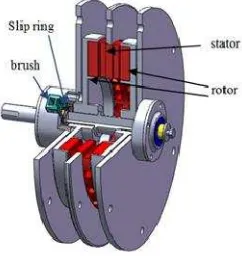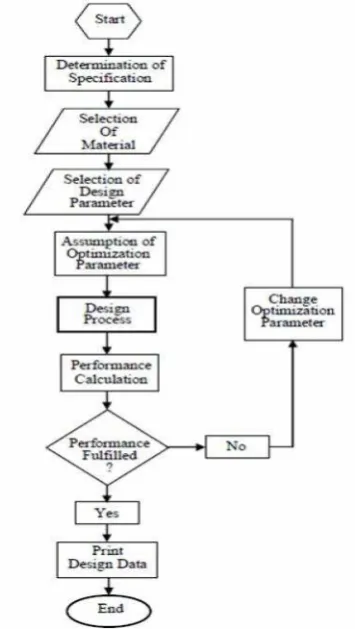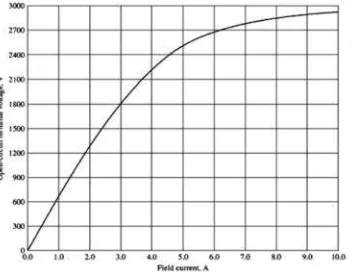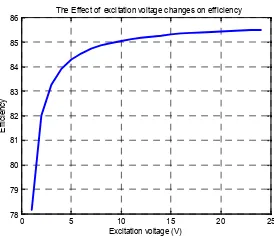Abstrak
Generator fluks aksial rotor belitan mempunyai belitan medan yang dihubungkan dengan sumber tegangan dc. Dengan mengatur tegangan eksitasi, maka unjuk kerjanya dapat diatur untuk memenuhi kebutuhan tegangan beban yang terpasang pada terminalnya. Generator yang dirancang berkapasitas skala kecil yang mempunyai1 kW, 380 V and 750 rpm. Generator mempunyai satu stator belitan dua sisi beralur yang diapit oleh rotor kembar. Pengaruh perubahan tegangan eksitasi terhadap unjuk kerja dapat dilihat dari hasil perhitungan yang menggunakan persamaan-persamaan. Hasil-hasil perhitungan menunjukkan besaran listrik telah memenuhi unjuk kerja mesin. Semakin tinggi tegangan eksitasi, semakin rendah rugi-ruginya sedangkan efisiensi dan tegangan terminal semakin tinggi. Telah diperoleh bahwa untuk tegangan eksitasi 11 V, maka efisiensi dan tegangan terminalnya masing-masing 85,12 % and 380 V.
Kata kunci:generator sinkron, fluks aksial, tegangan eksitasi, efisiensi, torsi
Abstract
The axial flux wound rotor generator has field winding that must be connected to a dc voltage source. By varying the excitation voltage, its electric performance might be controlled to meet the need of a load voltage attached to its terminal. The designed generator is small-scale capacity which has 1 kW, 380 V and 750 rpm. The generator has a single double-sided slotted wound stator sandwiched between twin rotor. The effect of excitation voltage changes on its performance can be seen from the result of calculations using the given equations. The calculation results reveal electric quantities suited with respect to performance of the machine. If the voltages increase, the losses will decrease; but higher the excitation voltage, higher the efficiency and the terminal voltage. It has been found out that for the excitation voltage11 V, the efficiency and the terminal voltage are 85.12 % and 380V respectively.
Keywords:synchronous generator, axial flux, excitation voltage, efficiency, terminal voltage
1. Introduction
As for the axial flux permanent magnet (PM) machines, they have a number of distinct advantages over radial flux machines (RFM). They can be designed to have a higher power-to-weight ratio resulting in less core material. Moreover, they have planar and easily adjustable air gaps. The noise and vibration levels are less than the conventional machines. Also, the direction of the main air gap flux can be varied and many discrete topologies can be derived. These benefits present the AFMs with certain advantages over conventional RFMs in various applications [1].
Figure 1. Axial flux machine configurations. (a) Single rotor - single stator structure, (b) Two rotor - single stator structure, (c) Single rotor -two stator structure,
(d) Three rotor - two stator structure
Electrical machine which has high power and high efficiency and also small dimensions while lower price is the axial flux permanent magnet machine. However, the study has not been performed yet in three phase axial flux wound rotor synchronous generator which the excitation voltage can be varied. The excitation voltage changes can affect machine parameters such as efficiency, losses and terminal voltage.
This research will analyze the effect of the excitation voltage changes on the performance of three phase axial flux synchronous generator. How it affects the efficiency, the current and the terminal voltage. With the limited generator output power, it will be sought at what excitation voltage is varied to obtain the highest efficiency. When the rotation of generator rotor is not constant caused by the prime mover rotation that is not constant, the output voltage generated by the generator varies. To make constant output voltage, the flux should be controlled by varying the field current flowing through the rotor winding. Therefore the expected advantage of the result of this study is to obtain a precise excitation voltage on the axial flux wound rotor (AFWR) synchronous machine having the capacity 1 kW with high efficiency.Since a large number of poles can be accommodated, these machines are ideal for low speed applications.
Figure 2. AFWR synchronous generator
In the case of engine/generator sets most interest has focused on axial flux generator topologies that have two rotor discs and one stator disc. Such an axial flux generator can be usefully integrated with an engine as it is axially very short and so can be mounted directly on the engine output shaft, eliminating the need for separate bearings or couplings. The generator has, or can be designed to have, a moment of inertia that makes the flywheel redundant [3].
machine, then selecting materials and assigning design parameters. Before processing the design of the electrical circuit, the magnetic circuit and the mechanics, it is first assumed the parameter optimizations associated with the specification of the machine. It is expected at the end of the design process, the performance of the machine is met the need. If the performance has not met yet, then the design process should be repeated by changing optimization parameters. If the performance has been met, the design data sheet can be printed. Stages of the design are shown in the flow chart in Figure 3. The process of optimization in the design of the machine aims to obtain higher efficiency with power output fixed previously.
Figure 3. The flow chart of design process
Figure 4. The slotted stators and rotor, before and after winding
In principle, the electromagnetic design of AFPM machines is similar to its radial flux PM (RFPM) counterparts with cylindrical rotors. However, the mechanical design, thermal analysis and assembly process are more complex [4]. Specifications of three phase AFWR synchronous generator designed is the nominal quantity (rated). Quantities include output power, terminal voltage (phase to phase), frequency, rotor rotation and power factor. The input power and the load torque are on the shaft of prime mover which rotates the generator rotor windings. The rotor winding is connected to a source of direct current so that the field current flows through the field winding. The field current produces a steady-state magnetic field in the rotor.
If the field winding is connected to the excitation voltage source, the field current flows in the winding. One way to increase the efficiency of synchronous generetor is by increasing the excitation voltage [5]. The field current flowing in the rotor winding can be adjusted to control the output voltage. Adjusting the field current means controlling the flux produced in the rotor winding. The internal generated voltage in the stator winding is proportional to the flux. Relation between the field current andthe internal generated voltage is shown in Figure 5. With this characteristic, it is possible to find the internal generated voltage of the generator for any given field current [6].
Figure 5.Open-circuit Characteristics of a synchronous generator
The quantities of the machine affected by the excitation voltage such as power output, armature current, losses and temperature are expressed the equations below [4, 7].
The real electrical output power of the synchronous generator can be expressed in phase quantities as
Total losses in the stator (
P
ST)= + (4)
stator temperature rise (
θ
st)= (5)
The field winding should be design for a voltage from 15 to 20 percent less than the exciter voltage to allow for the drop in voltage between field and the exciter and to allow for variations in the reluctance of magnetic field. Assuming an exciter voltage Vrand keeping 20% of
exciter voltage in reserve the voltage across the field coil, the field winding voltage
= (1 0,2) (6)
Voltage across each field coil
= (7)
Resistance of each field winding
= (8)
Current in field winding
= (9)
Dissipation coefficient (
C
dr)= (10)
Total loss in rotor (
P
fT)= + (11)
Rotor temperatur rise (
θ
ft)= (12)
Losses produced by the machine in thermal consist of electrical and mechanical losses:
1. Copper losses (P1w) are the resistive heating losses in thearmature winding and the field
2. The core losses(Pcore) are the hysteresis losses and eddy current losses occurring in the
metal of the machine. The core losses are taken as 5% of output power.
3. Friction and windage losses (Pf&w). Friction losses are losses caused by the friction of the
bearings in the machine, while windage losses are caused by the friction between the moving parts of the machine and the air inside the motor’s casing. The friction and windage losses are taken as 1% of output power [7].
4. Excitation losses (Pexci) contain field winding DC losses and brush and slip-ring losses. In
the design of drop voltage in each brush is less than 1 volt [5].
5. Stray load losses or miscellaneous losses (Pstray) are taken as 20% of the total copper
In the synchronous machine, the rotor turns at the same speed as the stator magnetic field
ωsync=ωm
3. Results and Analysis
The values of machine parameter obtained by the calculation with the help of MATLAB are used for analysis of the machine based on the output power. Core losses and friction and windage losses are assumed 5% and 7% of the output power respectively [1, 8]. The research issue is directed to excitation voltage changes that affect losses, efficiency and load torque of the machine. The output power is set to a fixed quantity initially, while the efficiency is sought to the highest quantity. Changing the excitation voltage, losses and efficiency also change. The efficiency is sought in the optimal value but with a fixed output power. The optimum efficiency is obtained by changing the excitaion voltage. The machine operation specifications required are shown in Table 1.
Table 1. Required specifications of machine operation
Quantity (unit) Value
The calculation results related to the performance of the machine at the output power 1 kW and the efficiency 85.12% are shown in Table 2. In the calculation of the efficiency, the excitation voltage is ranged from low to high values while the efficiency and output power is checked and selected.
3.1. Excitation Voltage Parameter
Figure 6. Relationships between excitation
voltage and stator temperature. Figure 11. Relationships between excitation voltage andterminal voltage.
270 The Effect of excitation voltage changes on losses
Excitation voltage (V)
86 The Effect of excitation voltage changes on efficiency
Excitation voltage (V)
1060 The Effect of excitation voltage changes on output power
Excitation voltage (V)
The Effect of excitation voltage changes on load torque
Excitation voltage (V)
The Effect of excitation voltage changes on stator temperature
Excitation voltage (V)
The Effect of excitation voltage changes on Terminal Voltage
3.2. Design Analysis
Calculation of the effect of excitation voltage changes on AFWR generator has been performed by Matlab sofware. The changes of excitation voltage affect the performance of the machine. The higher the excitation voltage, the higher output power, terminal voltage, efficiency, load torque and stator temperatur, but the lower the losses.
The magnitude of the losses is inversely related to the output power. The smaller a proportional to current squared.Therefore, if the excitation voltage increases, the stator temperature increases too.
The efficiency of 85.12% obtainedon the excitation voltage 11 V and total losses 183.7 W are constrained to the output power of 1 kW. If the efficiency in the calculation is changed, then machine parameters are changed too including power input and power output.
4. Conclusion
The excitation voltage requiredfor supplying field winding in the rotor must be determined properly, so that the performance of AFWR synchrounous generator can be obtained according to design parameter. If the the excitation voltage increases, the output power, efficiency, terminal voltage and load torque of the machine increase too. But the losses of the machine decreases.The increased excitation voltage is constrained by the capacity of the designed machine. It is found out that for theexcitation voltage of 11 V, the efficiency and the terminal voltage are 85.12% and 380 V respectively.
References
[1] M Aydin, S Huang and TA Lipo. Axial Flux Permanent Magnet Disc Machines: A Review, Wisconsin Electric Machines & Power Electronics Consortium, University of Wisconsin-Madison, Madison, WI 53706-1691. 2004: 1-4.
[2] Asko Parviainen. Design Of Axial-Flux Permanent-MagnetLow-Speed Machines And Performance Comparison between Radial-Flux and Axial-Flux Machines, Thesis for the degree of Doctor of Science (Technology). Lappeenranta University of Technology. Digipaino. 2005: 17-19.
[3] JR Bumby, R Martin, Axial Flux,Permanent Magnet Generators For Engine Integration, The 12th International Stirling Engine Conference. Durham. 2005: 1-5.
[4] Jacek F Gieras, Rong-Jie Wang, Maarten J Kamper. Axial Flux Permanen Magnet Brushless Machines. Kluwer Academic Publishers. London. 2004: 1-8.
[5] Ion Boldea. The Electric Generators Handbook: Synchronous Generators. Boca Raton: Taylor & Francis Group. 2006: 7-72-75.
[6] Stephen J Chapman. Electric Machinery Fundamentals. Fourth Edition. Singapore: McGraw-Hill, Inc. 2005: 283-292.
[7] KM Vishnu Murthy. Computer-Aided Design of Electrical Machines. Hyderabad: BS Publications. 2008: 160, 231.




